The Longevity-Frailty Hypothesis: Evidence from COVID-19 Death Rates in Europe
Abstract
:1. Introduction
2. Model
3. Data and Methods
3.1. Survival Environment Indicators
3.2. COVID-19 Mortality Risk
3.3. Control Variables
3.4. Statistical Models
4. Results
5. Robustness
5.1. Excess Mortality
5.2. Age-Specific Mortality
6. Conclusions
Author Contributions
Funding
Institutional Review Board Statement
Informed Consent Statement
Data Availability Statement
Acknowledgments
Conflicts of Interest
Appendix A
| Country | Survival Index | Cohort Survival | Period Survival | Life Expectancy at 65 | Elderly Care Index | % ≥ 65 Disabled Need Help | % ≥ 65 Need Help Personal Activities | % ≥ 65 Need Help House Activities |
|---|---|---|---|---|---|---|---|---|
| France | 2.557 | 1.522 | 1.590 | 1.404 | 2.270 | 1.400 | 0.678 | 1.839 |
| Spain | 2.220 | 1.271 | 1.410 | 1.249 | 2.258 | 1.496 | 1.266 | 1.149 |
| Italy | 1.975 | 1.172 | 1.208 | 1.125 | 2.208 | 1.816 | 0.810 | 1.185 |
| United Kingdom | 1.259 | 0.778 | 1.004 | 0.476 | 1.115 | 0.746 | 0.611 | 0.575 |
| Norway | 1.040 | 0.519 | 0.558 | 0.803 | −1.486 | −0.890 | −1.076 | −0.613 |
| Luxembourg | 0.978 | 0.192 | 0.744 | 0.839 | −1.144 | −0.362 | −1.217 | −0.418 |
| Belgium | 0.969 | 0.574 | 0.608 | 0.571 | 1.394 | 0.623 | 0.310 | 1.470 |
| Sweden | 0.951 | 0.578 | 0.402 | 0.744 | −0.415 | −0.528 | −0.219 | 0.029 |
| Denmark | 0.805 | 0.370 | 0.843 | 0.256 | −0.449 | −0.785 | 0.464 | −0.437 |
| Iceland | 0.776 | 0.970 | −0.015 | 0.458 | −1.525 | −0.944 | −0.905 | −0.794 |
| Austria | 0.762 | 0.489 | 0.323 | 0.583 | −1.514 | −0.814 | −0.840 | −0.967 |
| Finland | 0.468 | 0.372 | −0.024 | 0.536 | −2.158 | −1.460 | −0.949 | −1.322 |
| Netherlands | 0.416 | 0.440 | −0.071 | 0.423 | −1.114 | −0.873 | −0.822 | −0.239 |
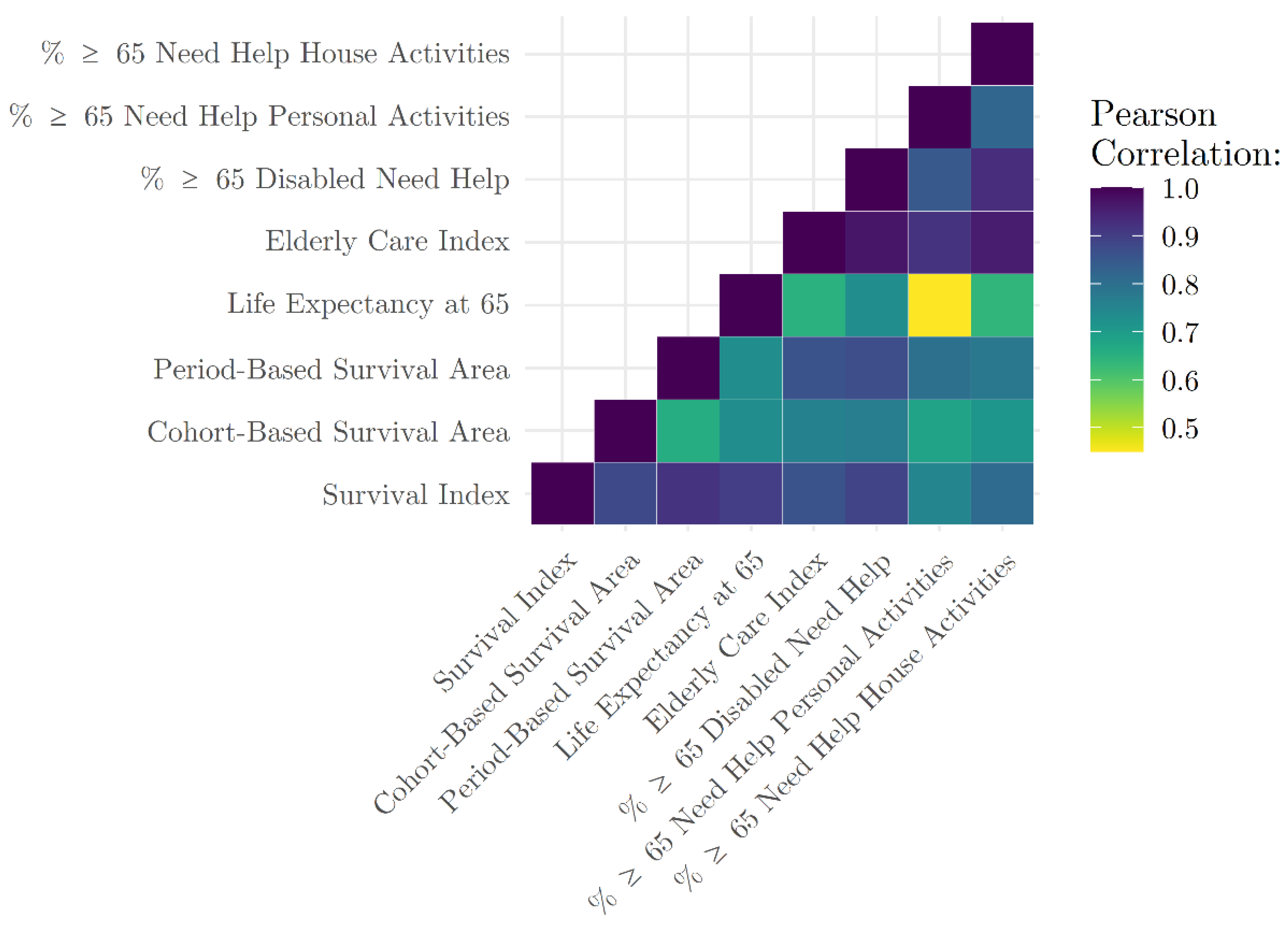
References
- Dowd, J.B.; Andriano, L.; Brazel, D.M.; Rotondi, V.; Block, P.; Ding, X.; Liu, Y.; Mills, M.C. Demographic science aids in understanding the spread and fatality rates of COVID-19. Proc. Natl. Acad. Sci. USA 2020, 117, 9696–9698. [Google Scholar] [CrossRef] [PubMed] [Green Version]
- Dudel, C.; Riffe, T.; Acosta, E.; van Raalte, A.; Strozza, C.; Myrskylä, M. Monitoring trends and differences in COVID-19 case-fatality rates using decomposition methods: Contributions of age structure and age-specific fatality. PLoS ONE 2020, 15, e0238904. [Google Scholar] [CrossRef]
- Hoogendijk, E.O.; Afilalo, J.; Ensrud, K.E.; Kowal, P.; Onder, G.; Fried, L.P. Frailty: Implications for clinical practice and public health. Lancet 2019, 394, 1365–1375. [Google Scholar] [CrossRef]
- Theou, O.; Squires, E.; Mallery, K.; Lee, J.S.; Fay, S.; Goldstein, J.; Armstrong, J.J.; Rockwood, K. What do we know about frailty in the acute care setting? a scoping review. BMC Geriatr. 2018, 18, 139. [Google Scholar] [CrossRef] [PubMed]
- Vetrano, D.L.; Palmer, K.M.; Galluzzo, L.; Giampaoli, S.; Marengoni, A.; Bernabei, R.; Onder, G. Hypertension and frailty: A systematic review and meta-analysis. BMJ Open 2018, 8, e024406. [Google Scholar] [CrossRef] [PubMed]
- Denfeld, Q.E.; Winters-Stone, K.; Mudd, J.O.; Gelow, J.M.; Kurdi, S.; Lee, C. The prevalence of frailty in heart failure: A systematic review and meta-analysis. Int. J. Cardiol. 2017, 236, 283–289. [Google Scholar] [CrossRef] [PubMed]
- Vogt, T.C.; Missov, T.I. Estimating the contribution of mortality selection to the east–west german mortality convergence. Popul. Health Metr. 2017, 15, 33. [Google Scholar] [CrossRef] [PubMed] [Green Version]
- Vaupel, J.; Manton, K.G.; Stallard, E. The impact of heterogeneity in individual frailty on the dynamics of mortality. Demography 1979, 16, 439–454. [Google Scholar] [CrossRef] [PubMed]
- Almond, D.; Currie, J. Killing me softly: The fetal origins hypothesis. J. Econ. Perspect. 2011, 25, 153–172. [Google Scholar] [CrossRef] [PubMed] [Green Version]
- Yancy, C.W. COVID-19 and African Americans. JAMA 2020, 323, 1891–1892. [Google Scholar] [CrossRef] [PubMed] [Green Version]
- Williamson, E.J.; Walker, A.J.; Bhaskaran, K.; Bacon, S.; Bates, C.; Morton, C.E.; Curtis, H.J.; Mehrkar, A.; Evans, D.; Inglesby, P.; et al. Factors associated with COVID-19-related death using OpenSAFELY. Nature 2020, 584, 430–436. [Google Scholar] [CrossRef] [PubMed]
- Williamson, E.; Walker, A.J.; Bhaskaran, K.; Bacon, S.; Bates, C.; Morton, C.E.; Curtis, H.J.; Mehrkar, A.; Evans, D.; Inglesby, P.; et al. OpenSAFELY: Factors associated with COVID-19-related hospital death in the linked electronic health records of 17 million adult nhs patients. medRxiv 2020. [Google Scholar] [CrossRef]
- Cutler, D.; Deaton, A.; Lleras-Muney, A. The determinants of mortality. J. Econ. Perspect. 2006, 20, 97–120. [Google Scholar] [CrossRef] [Green Version]
- Herby, J. Working Paper: Exceptionally Many Vulnerable–‘Dry Tinder’–in Sweden Prior to COVID-19. Available online: https://ssrn.com/abstract=3702595 (accessed on 6 October 2020). [CrossRef]
- Wilmoth, J.R.; Andreev, K.; Jdanov, D.; Glei, D.A.; Boe, C.; Bubenheim, M.; Philipov, D.; Shkolnikov, V.; Vachon, P.; Winant, C.; et al. Methods Protocol for the Human Mortality Database; University of California, Berkeley, and Max Planck Institute for Demographic Research: Rostock, Germany, 2021. [Google Scholar]
- Ahmed, S.M.; Nasr, M.A.; Elshenawy, S.E.; Hussein, A.E.; El-Betar, A.H.; Mohamed, R.H.; El-Badri, N. Bcg vaccination and the risk of COVID-19: A possible correlation. Virology 2022, 565, 73–81. [Google Scholar] [CrossRef] [PubMed]
- Halvorsen, R.; Palmquist, R. The interpretation of dummy variables in semilogarithmic equations. Am. Econ. Rev. 1980, 70, 474–475. [Google Scholar]
- Bhargava, A.; Franzini, L.; Narendranathan, W. Serial correlation and the fixed effects model. Rev. Econ. Stud. 1982, 49, 533–549. [Google Scholar] [CrossRef]
- Baltagi, B.H.; Wu, P.X. Unequally spaced panel data regressions with ar (1) disturbances. Econom. Theory 1999, 15, 814–823. [Google Scholar] [CrossRef] [Green Version]
- Comas-Herrera, A.; Zalakaín, J.; Litwin, C.; Hsu, A.T.; Lane, N.; Fernández, J.-L. Mortality associated with COVID-19 outbreaks in care homes: Early international evidence. Int. Long-Term Care Policy Netw. CPECLSE 2020, 26. Available online: https://ltccovid.org/wp-content/uploads/2020/05/Mortality-associated-with-COVID-26-April-1.pdf (accessed on 15 June 2020).
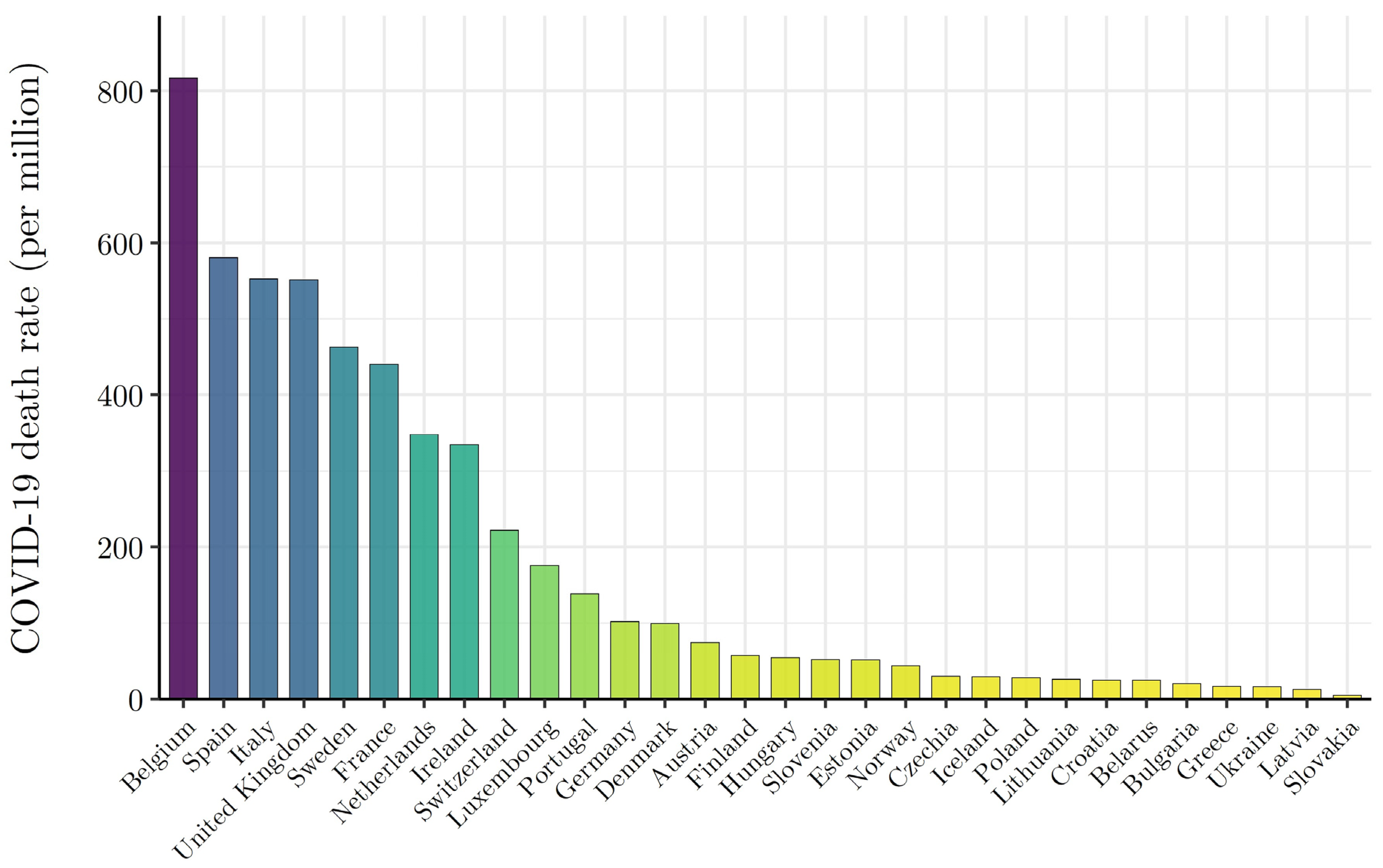
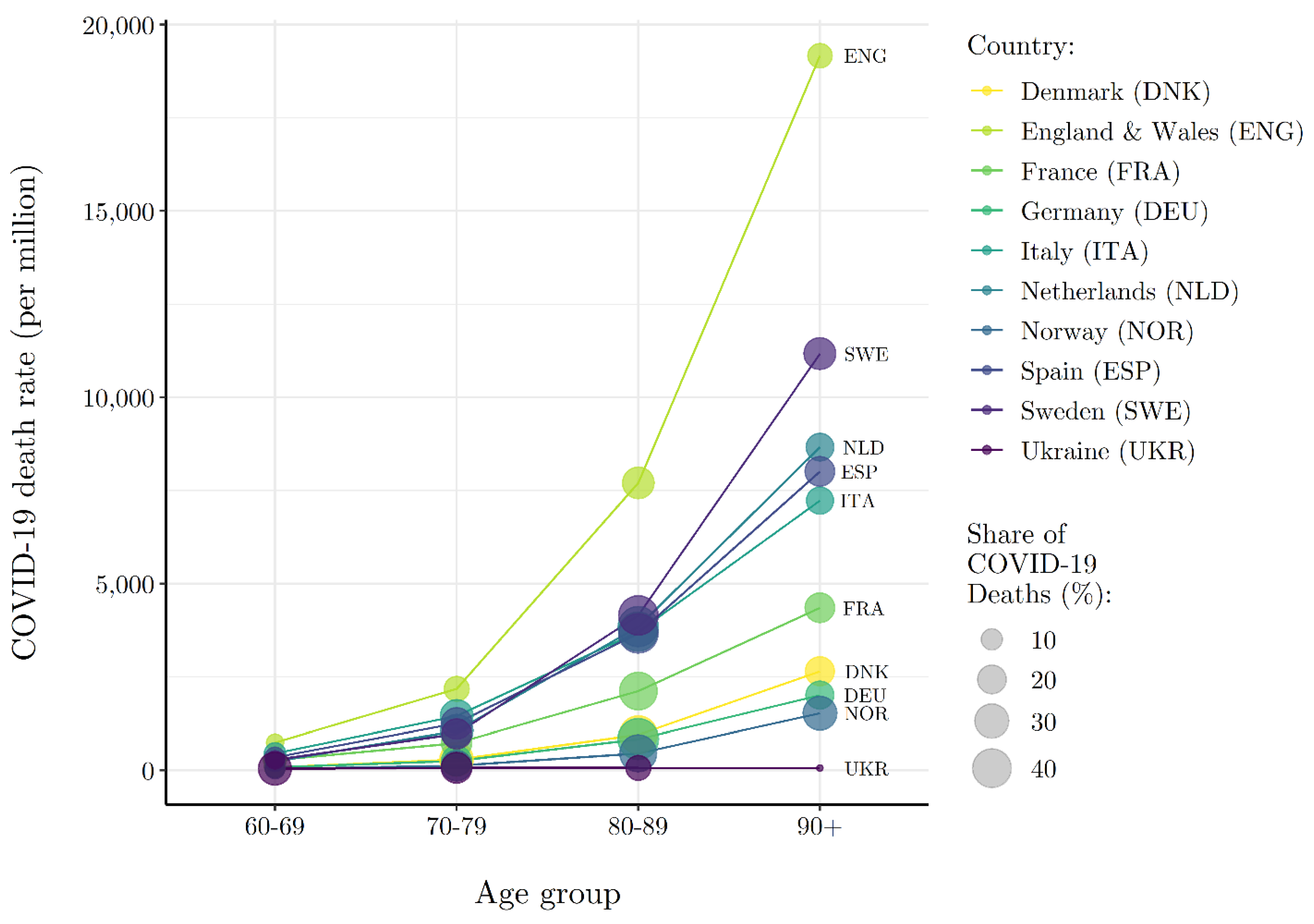
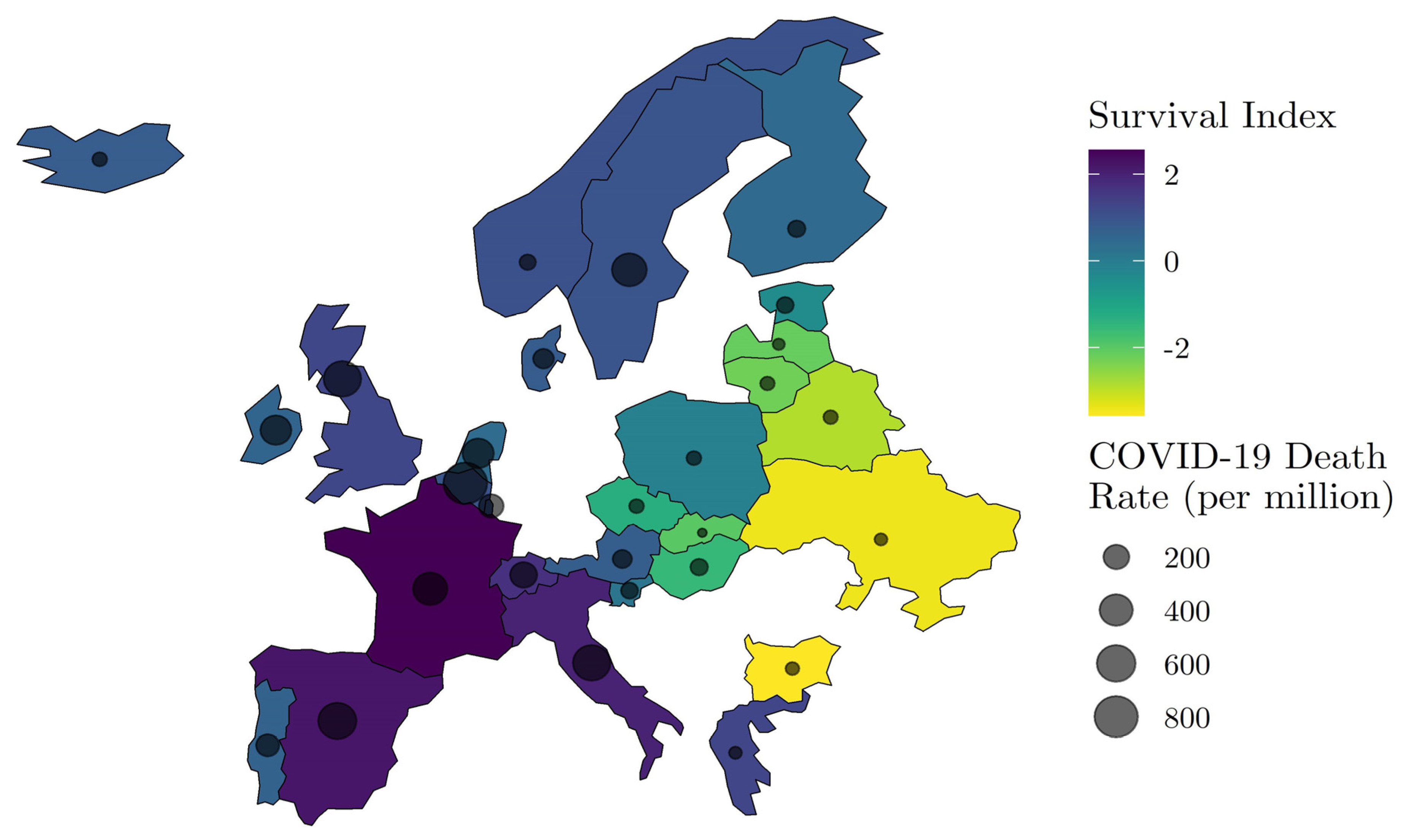
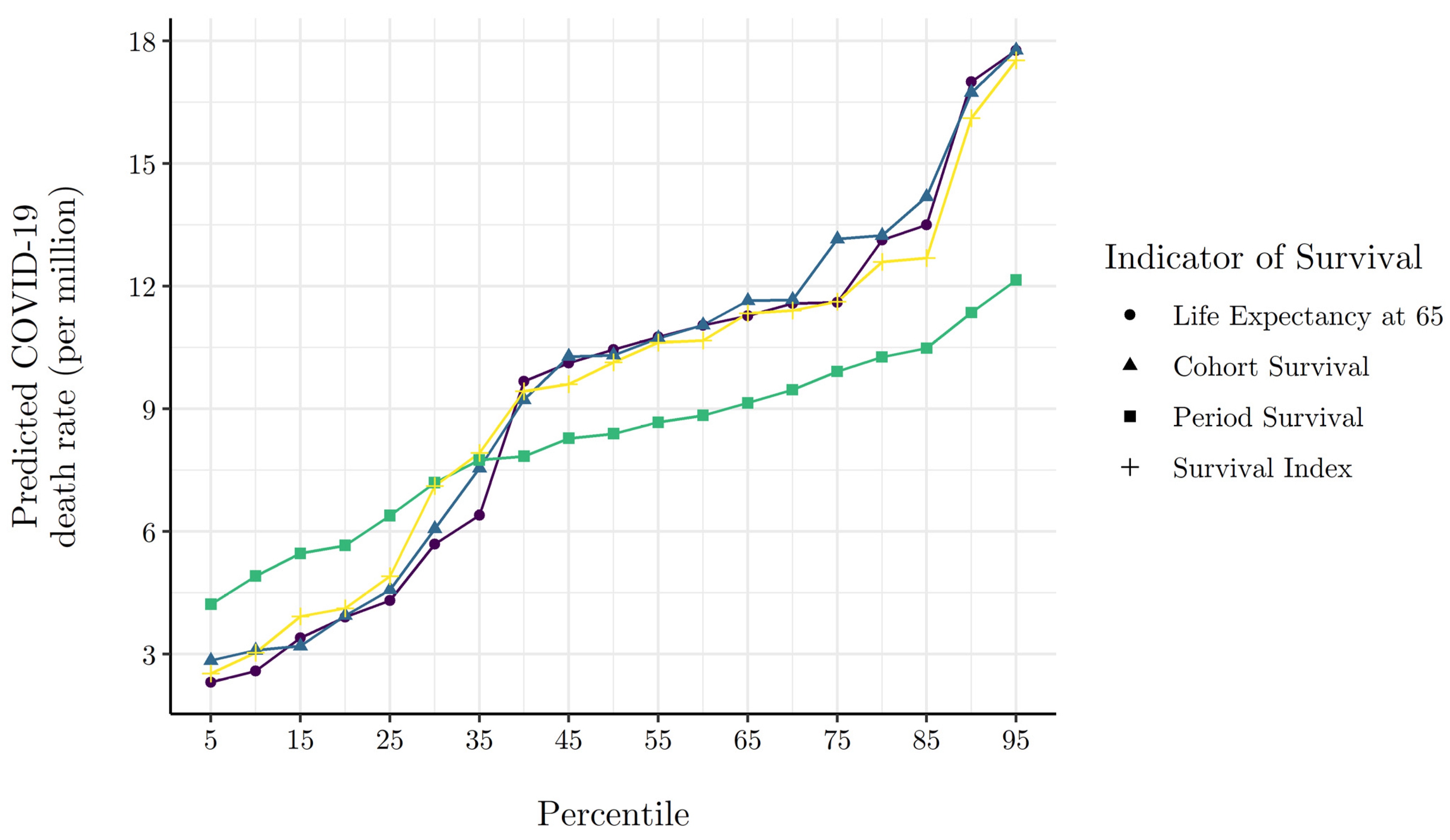
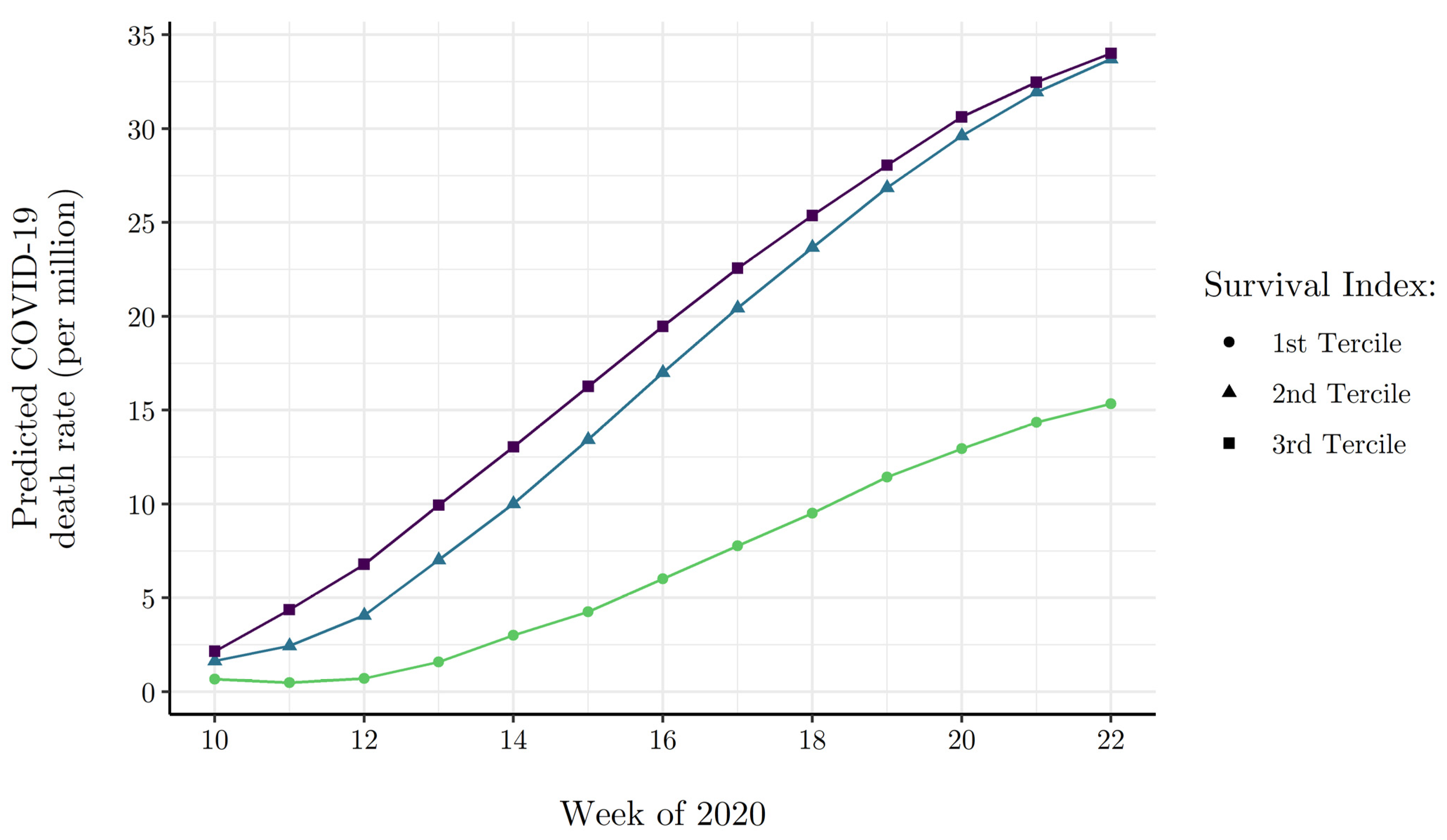
| (1) | (2) | (3) | (4) | (5) | (6) | (7) | (8) | |
|---|---|---|---|---|---|---|---|---|
| Life Expectancy at 65 (LE) | 12.73 *** (1.75) | 4.17 ** (1.86) | ||||||
| Cohort Survival (CS) | 132.35 *** (17.88) | 44.61 *** (16.92) | ||||||
| Period Survival (PS) | 176.67 *** (28.11) | 45.19 * (24.18) | ||||||
| Survival Index (SI) | 0.73 *** (0.098) | 0.23 *** (0.09) | ||||||
| Constant | −39.16 *** | −23.08 | −572.02 | −203.55 *** | −817.79 *** | −219.60 *** | −1.74 *** | −11.83 *** |
| (5.16) | (5.90) | (77.07) | (72.48) | (129.87) | (111.62) | (0.20) | (2.51) | |
| ρˆ | 0.91 | 0.85 | 0.90 | 0.85 | 0.91 | 0.85 | 0.90 | 0.85 |
| Bhargava et al. Durbin−Watson | 0.39 | 0.36 | 0.37 | 0.36 | 0.39 | 0.36 | 0.37 | 0.36 |
| Baltagi−Wu LBI | 0.42 | 0.41 | 0.41 | 0.40 | 0.42 | 0.41 | 0.41 | 0.40 |
| Observations | 2670 | 2670 | 2492 | 2492 | 2670 | 2670 | 2492 | 2492 |
| Countries | 30 | 30 | 28 | 28 | 30 | 30 | 28 | 28 |
| Country RE | Yes | Yes | Yes | Yes | Yes | Yes | Yes | Yes |
| Week FE | Yes | Yes | Yes | Yes | Yes | Yes | Yes | Yes |
| Controls | No | Yes | No | Yes | No | Yes | No | Yes |
| (1) | (2) | (3) | (4) | (5) | (6) | (7) | (8) | |
|---|---|---|---|---|---|---|---|---|
| LE Tercile II | 1.80 *** (0.41) | 0.65 ** (0.32) | ||||||
| LE Tercile III | 2.75 *** (0.41) | 1.08 *** (0.39) | ||||||
| CS Tercile II | 1.80 *** (0.46) | 0.52 (0.33) | ||||||
| CS Tercile III | 2.63 *** (0.46) | 0.90 ** (0.39) | ||||||
| PS Tercile II | 1.22 *** (0.46) | 0.40 (0.29) | ||||||
| PS Tercile III | 2.52 *** (0.46) | 0.66 ** (0.34) | ||||||
| SI Tercile II | 1.85 *** (0.41) | 0.84 *** (0.35) | ||||||
| SI Tercile III | 2.86 *** (0.41) | 1.09 *** (0.39) | ||||||
| Constant | −3.20 *** | −11.56 *** | −3.16 *** | 17.18 *** | −2.93 *** | −11.40 *** | −3.25 *** | −13.44 *** |
| (0.31) | (2.41) | (0.34) | (3.07) | (0.35) | (2.52) | (0.31) | (2.45) | |
| ρˆ | 0.91 | 0.85 | 0.90 | 0.90 | 0.91 | 0.85 | 0.90 | 0.85 |
| Bhargava et al. Durbin−Watson | 0.39 | 0.36 | 0.37 | 0.32 | 0.39 | 0.36 | 0.37 | 0.36 |
| Baltagi−Wu LBI | 0.42 | 0.41 | 0.41 | 0.35 | 0.42 | 0.41 | 0.41 | 0.40 |
| Observations | 2670 | 2670 | 2492 | 2492 | 2670 | 2670 | 2492 | 2492 |
| Countries | 30 | 30 | 28 | 28 | 30 | 30 | 28 | 28 |
| Country RE | Yes | Yes | Yes | Yes | Yes | Yes | Yes | Yes |
| Week FE | Yes | Yes | Yes | Yes | Yes | Yes | Yes | Yes |
| Controls | No | Yes | No | Yes | No | Yes | No | Yes |
| Title | (1) | (2) | (3) | (4) |
|---|---|---|---|---|
| Life Expectancy at 65 (LE) | 2.89 *** (0.84) | |||
| Cohort Survival (CS) | 28.56 *** (9.33) | |||
| Period Survival (PS) | 13.09 (9.24) | |||
| Survival Index (SI) | 0.05 ** (0.02) | |||
| Constant | −10.38 *** | −126.09 *** | −63.56 | −3.60 *** |
| (4.23) | (40.73) | (42.77) | (1.18) | |
| ρˆ | 0.92 | 0.92 | 0.91 | 0.93 |
| Observations | 247 | 234 | 247 | 234 |
| R−squared | 0.88 | 0.85 | 0.88 | 0.85 |
| Countries | 19 | 18 | 19 | 18 |
| Week FE | Yes | Yes | Yes | Yes |
| Controls | Yes | Yes | Yes | Yes |
| (1) | (2) | (3) | (4) | |
|---|---|---|---|---|
| All−Cause Death Rate (2016) | 1.112 *** | −1.439 *** | −4.313 *** | −0.653 *** |
| (0.010) | (0.041) | (0.095) | (0.034) | |
| Age 10–19 | −0.758 *** | −0.169 ** | ||
| (0.104) | (0.072) | |||
| Age 20–29 | 1.664 *** | 1.600 *** | ||
| (0.089) | (0.061) | |||
| Age 30–39 | 3.595 *** | 3.001 *** | ||
| (0.093) | (0.065) | |||
| Age 40–49 | 5.570 *** | 4.364 *** | ||
| (0.106) | (0.078) | |||
| Age 50–59 | 8.101 *** (0.132) | |||
| Age 60–69 | 10.408 *** (0.160) | |||
| Age 70–79 | 12.831 *** | 5.009 *** | ||
| (0.192) | (0.104) | |||
| Age 80–89 | 15.571 *** | 10.979 *** | ||
| (0.234) | (0.201) | |||
| Age ≥ 90 | 17.749 *** | 16.161 *** | ||
| (0.274) | (0.297) | |||
| Constant | 4.843 *** | −17.480 *** | −20.587 *** | −10.379 *** |
| (0.501) | (0.487) | (0.649) | (0.581) | |
| Observations | 4697 | 4697 | 2335 | 1820 |
| R−squared | 0.738 | 0.869 | 0.710 | 0.764 |
| Week FE | Yes | Yes | Yes | Yes |
| Age Interval FE | No | Yes | Yes | Yes |
Publisher’s Note: MDPI stays neutral with regard to jurisdictional claims in published maps and institutional affiliations. |
© 2022 by the authors. Licensee MDPI, Basel, Switzerland. This article is an open access article distributed under the terms and conditions of the Creative Commons Attribution (CC BY) license (https://creativecommons.org/licenses/by/4.0/).
Share and Cite
Zahran, S.; Altringer, L.; Prasad, A. The Longevity-Frailty Hypothesis: Evidence from COVID-19 Death Rates in Europe. Int. J. Environ. Res. Public Health 2022, 19, 2434. https://doi.org/10.3390/ijerph19042434
Zahran S, Altringer L, Prasad A. The Longevity-Frailty Hypothesis: Evidence from COVID-19 Death Rates in Europe. International Journal of Environmental Research and Public Health. 2022; 19(4):2434. https://doi.org/10.3390/ijerph19042434
Chicago/Turabian StyleZahran, Sammy, Levi Altringer, and Ashok Prasad. 2022. "The Longevity-Frailty Hypothesis: Evidence from COVID-19 Death Rates in Europe" International Journal of Environmental Research and Public Health 19, no. 4: 2434. https://doi.org/10.3390/ijerph19042434
APA StyleZahran, S., Altringer, L., & Prasad, A. (2022). The Longevity-Frailty Hypothesis: Evidence from COVID-19 Death Rates in Europe. International Journal of Environmental Research and Public Health, 19(4), 2434. https://doi.org/10.3390/ijerph19042434





